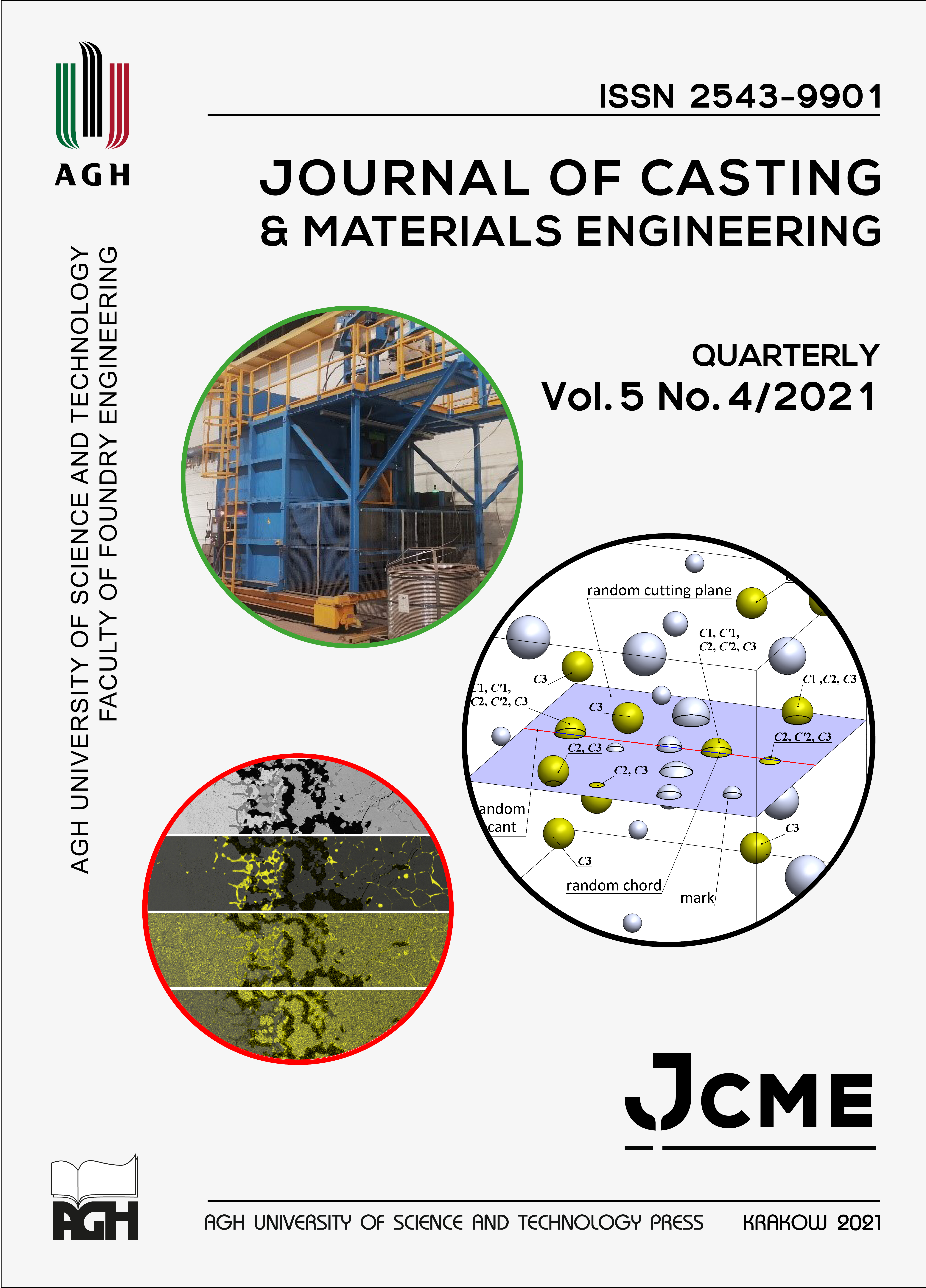Research on Mechanical and Electrical Properties of Cu-Ag Alloys Designed for the Construction of High Magnetic Field Generators
DOI:
https://doi.org/10.7494/jcme.2021.5.4.103Abstract
The individual sections, wiring and construction of electromagnet windings responsible for strong magnetic field impulses may be one application for hypoeutectic Cu-Ag alloys. High electrical properties and mechanical properties (tensile strength, yield strength, impact strength) as well as high heat, fatigue and rheological resistance are required for these kinds of applications due to the unique nature of such operations (strong vibrations of high frequency and amplitude resulting from Lorenz forces and the possibility of significant and rapid heating from Jule’s heat). The limited solubility of copper and silver in the solid state enables the effective modification of the alloys’ microstructure through heat treatment and further shaping of their high mechanical and electrical properties via cold plastic working. The article presents the manufacturing of Cu-Ag alloys with the weight percent of Ag between 3 and 7 using the continuous casting process along with research on the physicochemical, mechanical and electrical properties of the obtained casts. The research on the amount of plastic deformation and its influence on the wire drawing process and the mechanical and electrical properties of the wires is also discussed. The temperature coefficients of resistance were defined in order to determine the temperature influence on the electrical resistance changes dynamics. The microstructural analysis was carried out in the as-cast state. The preliminary research conducted indicates that the obtained Cu-Ag alloys in the as-cast state exhibit a set of high mechanical and electrical properties. The prospective next stage of research includes the selection of favourable heat treatment parameters which would provide optimally modified microstructure of the alloys, as well as determining the deformation coefficients allowing for further increases in the mechanical and electrical properties.
Downloads
References
Freudenberger J., Klauss H.-J., Heinze K., Gaganov A., Schaper M. & Schultz L. (2008). Fatigue of highly strengthened Cu-Ag alloys. International Journal of Fatigue 30(3), 437–443. Doi: https://doi.org/10.1016/J.IJFATIGUE.2007.04.009.
Van Bockstal L., Li L., Harrison N., Heremans G., Herlach F., Starett B. & Clark G.G. (1996). Long life pulsed high field magnets with CuAg conductor and internal reinforcement. IEEE, 32(4), 2514–2417. Doi: https://doi.org/10.1109/20.511384.
Wood J.T., Embury J.D. & Ashby M.F. (1997). An approach to materials processing and selection for high-field magnet design. Acta Materialia, 45(3), 1099–1104. Doi: https://doi.org/10.1016/S1359-6454(96)00220-0.
Strzępek P., Mamala A., Zasadzińska M., Noga P. &Sadzikowski M. (2020). The influence of the continuous casting conditions on the properties of high-strength two-phase CuMg alloys. Materials, 13(21), 4805. Doi: https://doi.org/10.3390/ma13214805.
Strzępek P., Mamala A., Zasadzińska M., Franczak K. & Jurkiewicz B. (2019). Research on the drawing process of Cu and CuZn wires obtained in the cryogenic conditions. Cryogenics, 100, 11–17. Doi: https://doi.org/10.1016/j.cryogenics.2019.03.007.
Zasadzińska M., Knych T., Smyrak B. & Strzępek P. (2020). Investigation of the dendritic structure influence on the electrical and mechanical properties diversification of the continuously casted copper strand. Materials, 13(23), 5513. Doi: https://doi.org/10.3390/ma13235513.
Zasadzińska M. & Knych T. (2019). The morphology of eutectic copper oxides I (Cu2O) in the processing of wire rod and wires made from ETP grade copper. Archives of Metallurgy and Materials, 64, 1611–1616. Doi: https://doi.org/10.24425/amm.2019.130134.
Zasadzińska M., Knych T., Strzępek P., Jurkiewicz B. & Franczak K. (2019). Analysis of the strengthening and recrystallization of electrolytic copper (Cu-ETP) and oxygen free copper (Cu-OF). Archives of Civil and Mechanical Engineering, 19(1), 186–193. Doi: https://doi.org/10.1016/j.acme.2018.09.008.
Han K., Embury J.D., Sims J.R., Campbell L.J., Schneider-Muntau H.-J., Pantsyrnyi V.I., Shikov A., Nikulin A. & Vorobieva A. (1999). The fabrication, properties and microstructure of Cu-Ag and Cu-Nb composite conductors. Material Science and Engineering: A, 267(1), 99–114. Doi: https://doi.org/10.1016/S09215093(99)00025-8.
Zasadzińska M., Strzępek P., Mamala A. & Noga P. (2020). Reinforcement of Aluminium-Matrix Composites with Glass Fibre by Metallurgical Synthesis. Materials, 13(23), 5441. Doi: https://doi.org/10.3390/ma13235441.
Sakai Y., Inoue K., Asano T., Wada H. & Maeda H. (1991). Development of high-strength high-conductivity Cu-Ag alloys for high-field pulsed magnet use. Applied Physics Letters, 59(23), 2965–2967. Doi: https://doi.org/10.1063/1.105813.
Hirota T., Imai A., Kumano T., Ichihara M., Sakai Y., Inoue K. & Maeda H. (1994). Development of Cu-Ag alloys conductor for high field magnet. IEEE Transaction on Magnetics, 30(4), 1891–1894. Doi: https://doi.org/10.1109/20.305631.
Sakai Y. & Schneider-Muntau H.J. (1997). Ultra-high strength, high conductivity Cu-Ag alloy wires. Acta Materialia, 45(3), 1017–1023. Doi: https://doi.org/10.1016/S1359-6454(96)00248-0.
Sakai Y., Inoue K. & Maeda H. (1995). New high-strength, high-conductivity Cu-Ag alloy sheets. Acta Metallurgica et Materialia, 43(4), 1517–1522. Doi: https://doi.org/10.1016/0956-7151(94)00376-S.
Lin J. & Meng L. (2008). Effect of aging treatment on microstructure and mechanical properties of Cu-Ag alloys. Journal of
Alloys and Compounds, 454(1–2), 150–155. Doi: https://doi.org/10.1016/J.JALLCOM.2006.12.073.
Gupta S.P. (1998). Kinetics of discontinuous precipitation and dissolution in Cu-Ag alloys. Canadian Metallurgical Quarterly, 37(2), 141–159. Doi: https://doi.org/10.1179/cmq.1998.37.2.141.
Bao G., Xu Y., Huang L., Lu X., Zhang L., Fang Y., Meng L. & Liu J. (2016). Strengthening effect of Ag precipitates in Cu-Ag alloys: A quantitative approach. Materials Research Letters, 4(1), 37–42. Doi: https://doi.org/10.1080/21663831.2015.1091795.
Cho H., Lee B.S., Kang B.H. & Kim K.Y. (2008). Ageing behavior of Cu-Ag alloys. Advanced Materials Research, 47–50, 1051–1054. Doi: https://doi.org/10.4028/www.scientific.net/AMR.47-50.1051.
Meng L. & Liu J.B. (2007). Progress and current status in research on nanostructured Cu-Ag microcomposites for conductor wires. Material Science Forum, 539–543, 2798–2803. Doi: 10.4028/www.scientific.net/MSF.539-543.2798.
Gaganov A., Freudenberger J., Grunberger W. & Schultz L. (2004). Microstructural evolution and its effect on the mechanical properties of Cu-Ag microcomposites. Zeitschrift für Metallkunde, 95(6), 425–432.
Ning Y., Zhang X. & Wu Y. (2007). Electrical Conductivity of Cu-Ag in situ filamentary composites. Transactions of Nonferrous Metals Society of China 17(2), 378–383. Doi: https://doi.org/10.1016/S1003-6326(07)60102-2.
Strzępek P., Mamala A., Zasadzińska M., Kiesiewicz G. & Knych T.A. (2021). Shape analysis of the elastic deformation region throughout the axi-symmetric wire drawing process of ETP grade copper. Materials, 14(16), 4713. Doi: https://doi.org/10.3390/ma14164713.
Downloads
Published
Issue
Section
License
Copyright (c) 2021 Artur Kawecki, Eliza Sieja-Smaga, Kinga Korzeń, Magdalena Majchrowska, Piotr Noga

This work is licensed under a Creative Commons Attribution 4.0 International License.
How to Cite
Accepted 2022-01-12
Published 2021-12-29


